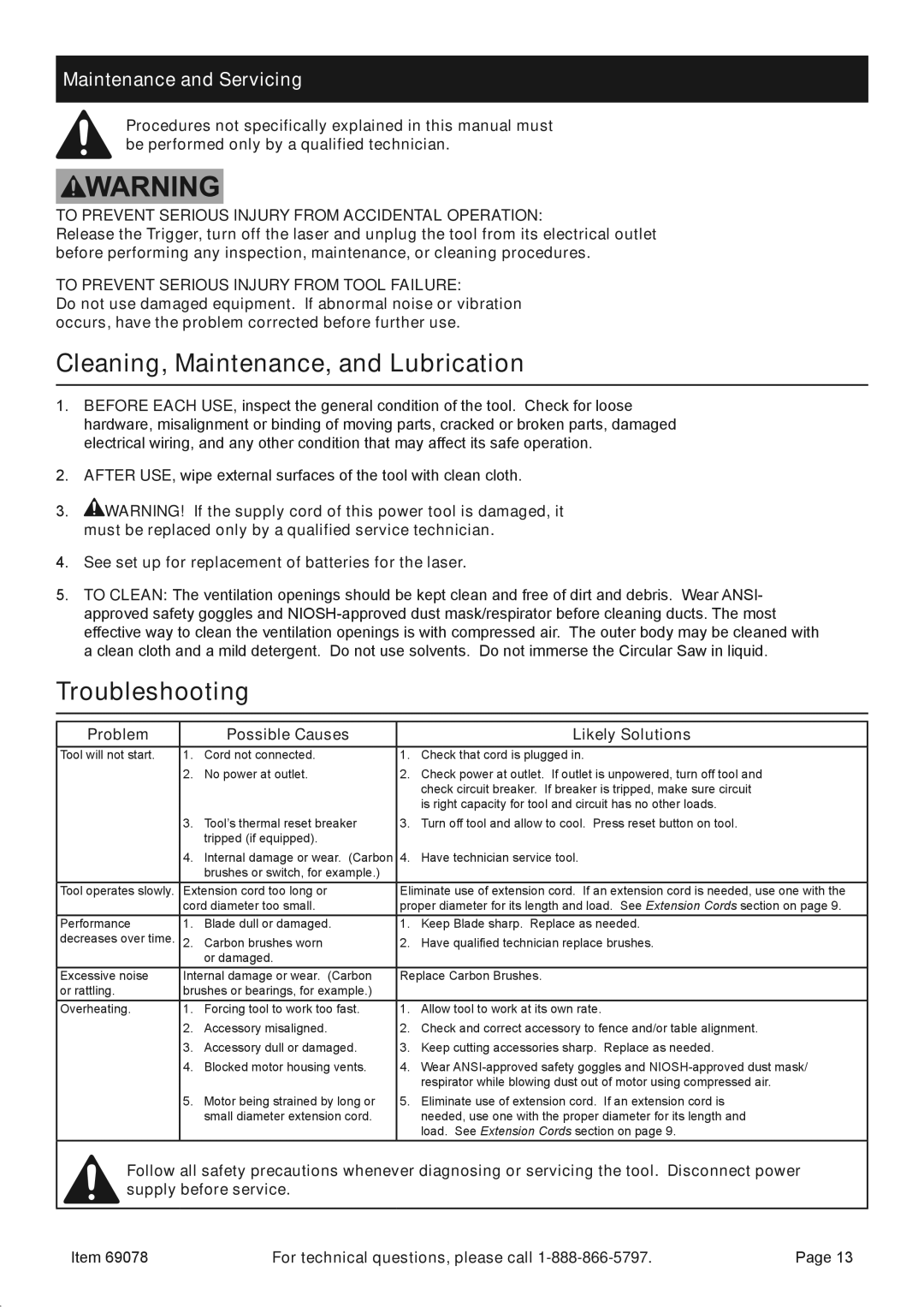
Maintenance and Servicing
Procedures not specifically explained in this manual must be performed only by a qualified technician.
TO PREVENT SERIOUS INJURY FROM ACCIDENTAL OPERATION:
Release the Trigger, turn off the laser and unplug the tool from its electrical outlet before performing any inspection, maintenance, or cleaning procedures.
TO PREVENT SERIOUS INJURY FROM TOOL FAILURE:
Do not use damaged equipment. If abnormal noise or vibration occurs, have the problem corrected before further use.
Cleaning, Maintenance, and Lubrication
1.BEFORE EACH USE, inspect the general condition of the tool. Check for loose hardware, misalignment or binding of moving parts, cracked or broken parts, damaged electrical wiring, and any other condition that may affect its safe operation.
2.AFTER USE, wipe external surfaces of the tool with clean cloth.
3.![]() WARNING! If the supply cord of this power tool is damaged, it must be replaced only by a qualified service technician.
WARNING! If the supply cord of this power tool is damaged, it must be replaced only by a qualified service technician.
4.See set up for replacement of batteries for the laser.
5.TO CLEAN: The ventilation openings should be kept clean and free of dirt and debris. Wear ANSI- approved safety goggles and
Troubleshooting
Problem |
| Possible Causes |
| Likely Solutions |
Tool will not start. | 1. | Cord not connected. | 1. | Check that cord is plugged in. |
| 2. | No power at outlet. | 2. | Check power at outlet. If outlet is unpowered, turn off tool and |
|
|
|
| check circuit breaker. If breaker is tripped, make sure circuit |
|
|
|
| is right capacity for tool and circuit has no other loads. |
| 3. | Tool’s thermal reset breaker | 3. | Turn off tool and allow to cool. Press reset button on tool. |
|
| tripped (if equipped). |
|
|
| 4. | Internal damage or wear. (Carbon | 4. | Have technician service tool. |
|
| brushes or switch, for example.) |
|
|
Tool operates slowly. | Extension cord too long or | Eliminate use of extension cord. If an extension cord is needed, use one with the | ||
| cord diameter too small. | proper diameter for its length and load. See Extension Cords section on page 9. | ||
Performance | 1. | Blade dull or damaged. | 1. | Keep Blade sharp. Replace as needed. |
decreases over time. | 2. | Carbon brushes worn | 2. | Have qualified technician replace brushes. |
|
| or damaged. |
|
|
Excessive noise | Internal damage or wear. (Carbon | Replace Carbon Brushes. | ||
or rattling. | brushes or bearings, for example.) |
|
| |
Overheating. | 1. | Forcing tool to work too fast. | 1. | Allow tool to work at its own rate. |
| 2. | Accessory misaligned. | 2. | Check and correct accessory to fence and/or table alignment. |
| 3. | Accessory dull or damaged. | 3. | Keep cutting accessories sharp. Replace as needed. |
| 4. | Blocked motor housing vents. | 4. | Wear |
|
|
|
| respirator while blowing dust out of motor using compressed air. |
| 5. | Motor being strained by long or | 5. | Eliminate use of extension cord. If an extension cord is |
|
| small diameter extension cord. |
| needed, use one with the proper diameter for its length and |
|
|
|
| load. See Extension Cords section on page 9. |
Follow all safety precautions whenever diagnosing or servicing the tool. Disconnect power supply before service.
Item 69078 | For technical questions, please call | Page 13 |
SAFETY
SETUP
OPERATION
MAINTENANCE
